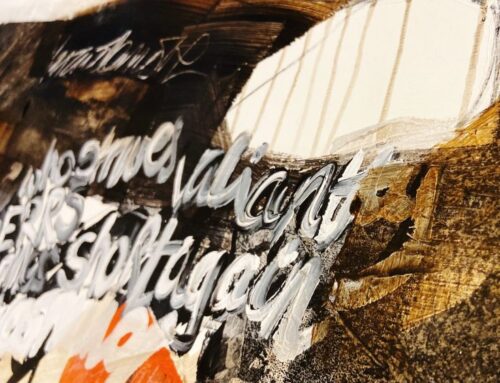‘DEAR MAZ; Correspondence with creatives; a series of emails seeking support and guidance from someone who has been there…
Dear Maz
I’ve been reading a book called ‘Get the Picture’ by Bianca Bosker, which is all about trying to understand the art world. And so far, it seems that there are so many people making art but only a few people who control what is good, and what is not, and that it still seems to be very elitist. This I think is true! But how can you get round this?
I do often feel complete overwhelm from constantly being told what we should be doing to get recognition; there is so much emphasis on being visible and the absolute need to push ourselves in that way. I’m on Instagram and have a love/ hate relationship with it, but mostly it drives me mad, and it drives me mad that it drives me mad! I don’t even make many sales through it! There’s this thing about finding your niche or your tribe, but how on earth do you do that?
I have artist friends who seem quite relaxed about things and just make art, but I feel I want to sell, I’m 65 and feel I still have many years ahead of me so why not?
At the moment I don’t have a proper studio, for various domestic reasons, so at the moment I’m on the kitchen table doing small works on paper as I’m really really messy! Hopefully something will turn up soon and I can get back into painting!
I don’t know if you can help Maz? But any advice would be greatly appreciated.
Frances

Work in Progress, in the studio of Maryanne Hawes
Hi Frances
Regarding the art world’s complexities and elitism, it’s true that a small number of gatekeepers often dictate the narrative and determine the ‘value’ of art. Who amongst us has never questioned the validity of our work and considered suppressing our own unique and hard fought-for style in favour of conforming to mainstream tastes? This Art World was not made for the likes of you and me, so we must create our own.
Thankyou, by the way, for introducing me to Bianca Bosker’s book ‘Get The Picture’. In it, and as a result of getting up close and personal with the Art World (deliberate use of capitals!) says she hopes to empower people to develop their eye and trust themselves. She reminds us that “What we see in these hallowed halls of culture (museums and galleries) is not necessarily the “best” but the result of a series of decisions by flawed individuals who are all like us – read subjective; “
The right audience, your ‘tribe,’ who trust themselves enough to love your work, is out there. They may be found in unexpected places, perhaps outside the traditional gallery system or within niche online communities. We are blessed, if you can call it that, with myriad alternative platforms and communities that celebrate diversity in artistic expression. The challenge, and indeed the opportunity, lies in finding or creating spaces where your art resonates. This is not a call to conform but to persist, to continue exploring and expressing your unique voice. Alok Vaid-Menon, a Performance Artist and Writer, says “I persist, not for validation, but for the necessity of my voice in spaces that never expected it to exist.”
This means you don’t need to suffer the anxiety and pressure to conform to perceived standards of success on social media and visibility in the art world. This is where we can get so caught up in what we “should” be doing that it stifles our natural creative flow; it’s so easy to get to the point where we are stuck in fear and rumination. But I think you are SO close to the point where the need to paint for YOU is going to bulldoze through these barriers. Could you try to paint a small series that the world will never see? How would they be different from your normal work? How would it feel to not receive ANY feedback?
Now, social media…. Instagram is a powerful tool for visibility, but it’s not the sole avenue for success or validation. The balance between its usefulness and the pressure it can exert is becoming almost untenable. It’s perfectly OK to step back and reassess how it serves your artistic journey. Its perfectly OK not to show your face, or post a reel every day, or spend hours editing videos. Remember, the core of your work lies in its creation, not in the likes or follows. But you already know this, my friend. Maybe it would help to think of Instagram as something that serves you, primarily, not the other way round. It is a record, a scrapbook or a journal, of the work you’ve been doing and your progress over time. It’s a memory of experiments failed, successes achieved, seasons passed. You won’t ‘beat the algorithm,’ and you probably won’t find the majority of your buyers there. So just use it in a way that serves you best, as you would a tube of paint or a blank canvas.
It’s also a great way to connect with those with whom you feel a kindred spirit. I have made long standing, close and meaningful friendships on instagram. I ‘met’ my peer mentor and good friend Mel in the DM’s; both of us fairly hard-core introverts living far apart, we communicate weekly by voice message, with no pressure to answer immediately or at all. It’s an opportunity to ask advice, bounce ideas or just chew the cud of life. Once a year we spend a week together and just paint. I will always be thankful to Instagram to have Mel in my life.
If you can’t find your support network, why not create it? Cultivate relationships with other artists and supportive individuals who understand the creative journey. Feedback is such a valuable tool for growth, whether in the giving or receiving. A trusted circle of peers, mentors, or online communities can help you learn to separate useful feedback from personal taste and use it as a stepping stone for improvement. Regular interaction with people who encourage and believe in your work can boost your confidence and perspective.
Your current situation, working on small pieces at the kitchen table, speaks to the adaptability and spirit of a true artist. Your art is not confined by your physical space; it’s carried within you and can- is- adapting to your circumstances. Small works on paper can be as profound as large canvases. This might also be a moment to explore mediums or subjects you’ve not had the chance to previously. Let your creativity flow. Optimise your current working area for efficiency and inspiration, even if it’s temporary. When you’re ready, you can explore opportunities for shared studio spaces as potential alternatives.
We’ve covered a lot here, Frances. But I think it comes down to the ‘why’ behind your art-making, a question which involves introspection and self-discovery. This journey is as much about inward reflection as it is about outward exploration. It involves understanding the essence of what drives you to create and seeking out those who resonate with that essence. It’s a process, often evolving, and it’s okay to not have all the answers. As I said at the beginning, this is all part of the work of the artist.
Ask yourself what drew you to art initially. What was the spark that made you want to create? Reflecting on your origins in art can often reveal the motivations that still drive you. Consider what values are most important to you both in life and in your art. Is it self-expression, communication, innovation, beauty, or perhaps a way to process emotions and experiences? Your core values often guide your reasons for making art.
Think about what effect you want your art to have on others. Do you want to provoke thought, provide an escape, invoke emotions, or challenge societal norms? Understanding the impact you aim to have can clarify your purpose.
Based on your reflections, write a personal Mission Statement or manifesto for your art practice. This should encapsulate why you make art, what you hope to achieve with it, and how it aligns with your personal values and goals. For inspiration, look at Richard Diebenkorn’s ten notes on beginning a painting, a set of ‘artistic intentions,’ they are a valuable insight into the mind of the artist, revealing how the artist focused and challenged himself in his work.
You can talk to close friends, family, or fellow artists about your art and why they think you create it. Or even create a post on Instagram! Sometimes, outsiders can see aspects of our motivation that we overlook. Your ‘why’ can evolve over time. Make it a habit to revisit your motivations and mission statement regularly to see if they still resonate or need updating based on your growth and experiences as an artist.
By carefully evaluating the reasons behind your art making, you can gain a clearer understanding of your purpose and direction, which can be a powerful source of motivation and fulfilment.
Lastly, remember, your journey is uniquely yours. You’ve questioned, persisted, and triumphed. Age doesn’t diminish your struggles but brings a wisdom that has strengthened your creative spirit. Keep painting, keep exploring, and most importantly, keep believing in the value of what you do. Your path may not be linear, but it is meaningful, and it matters.
With respect, encouragement, and admiration
Maz x




